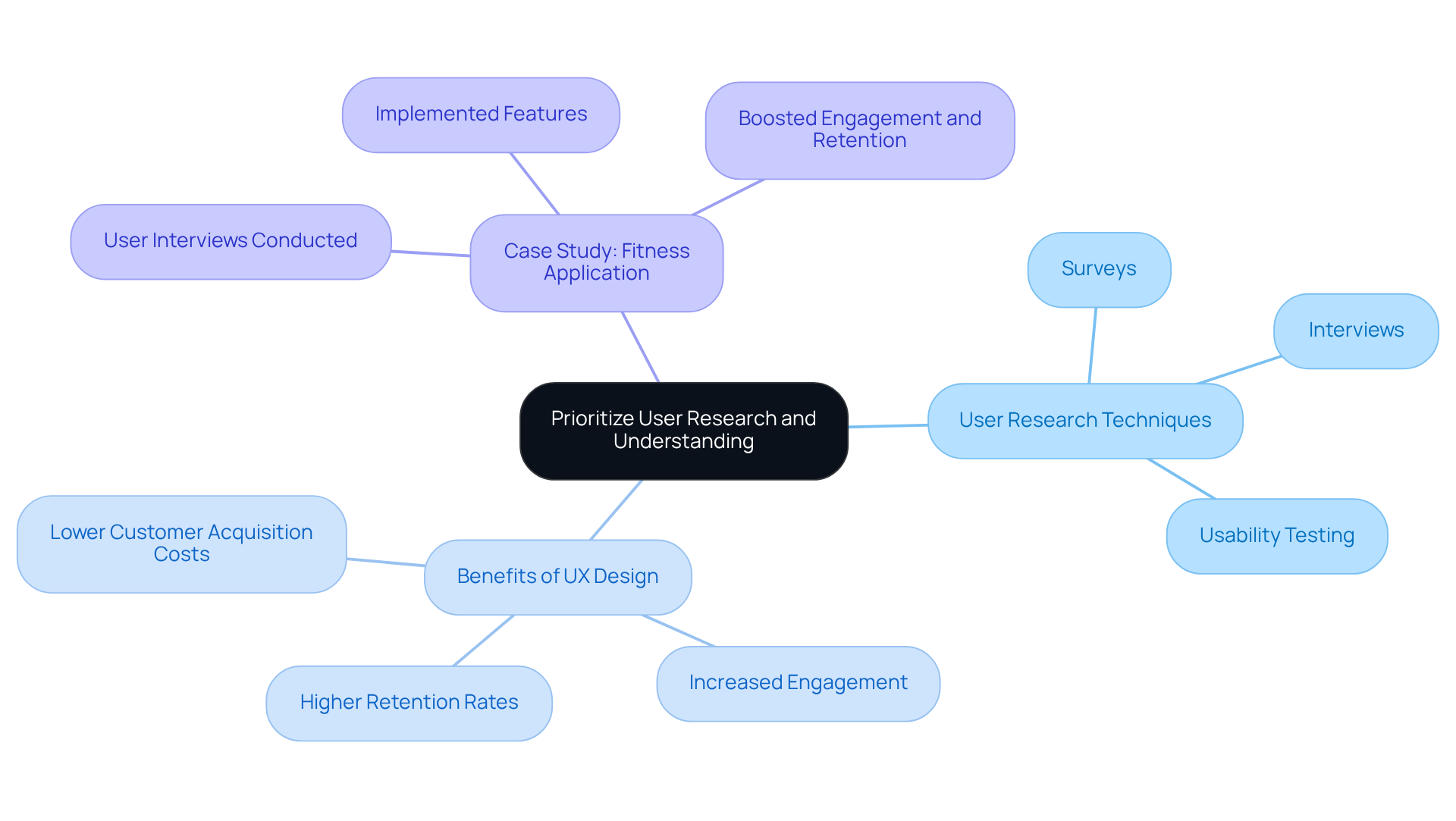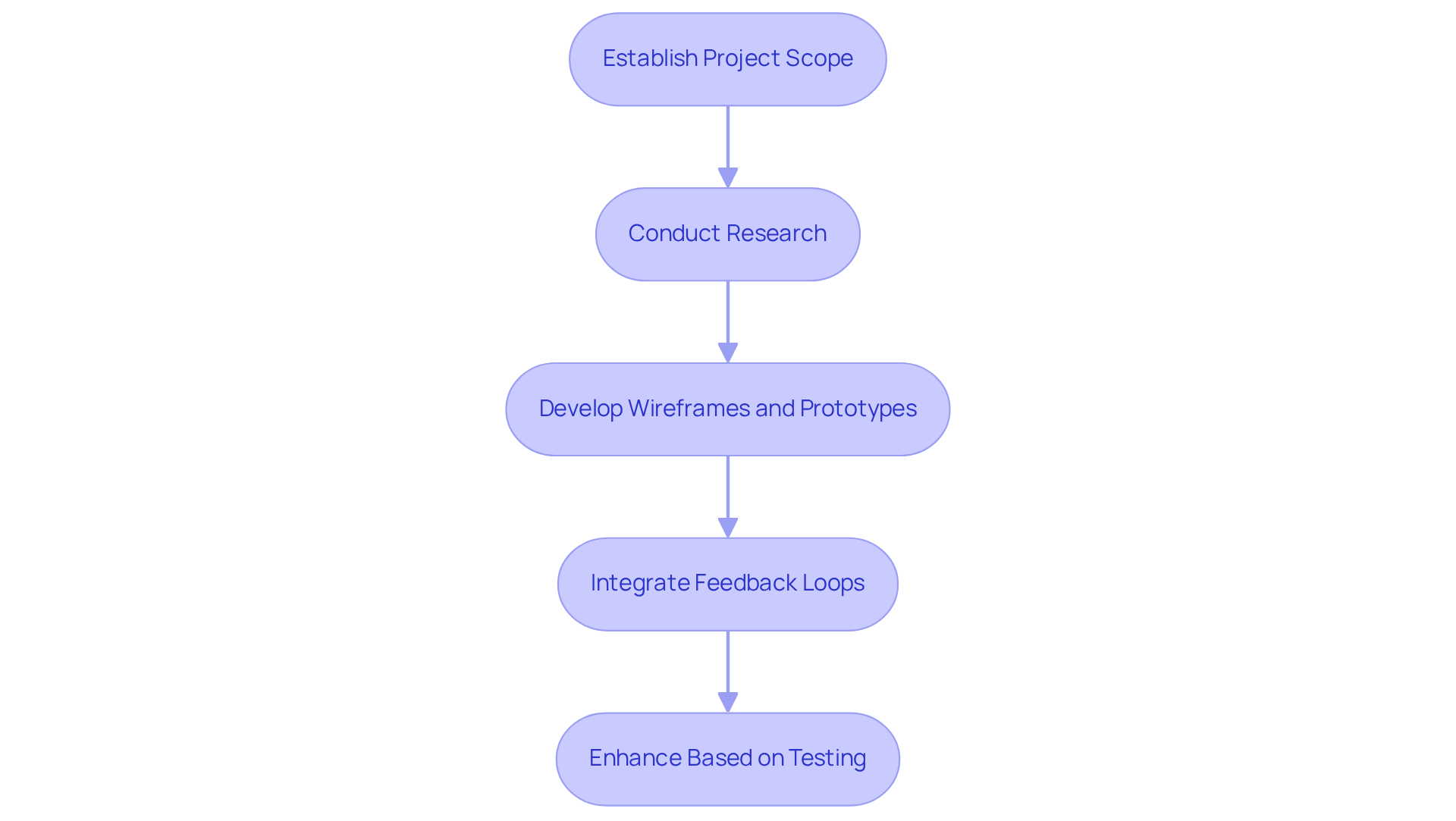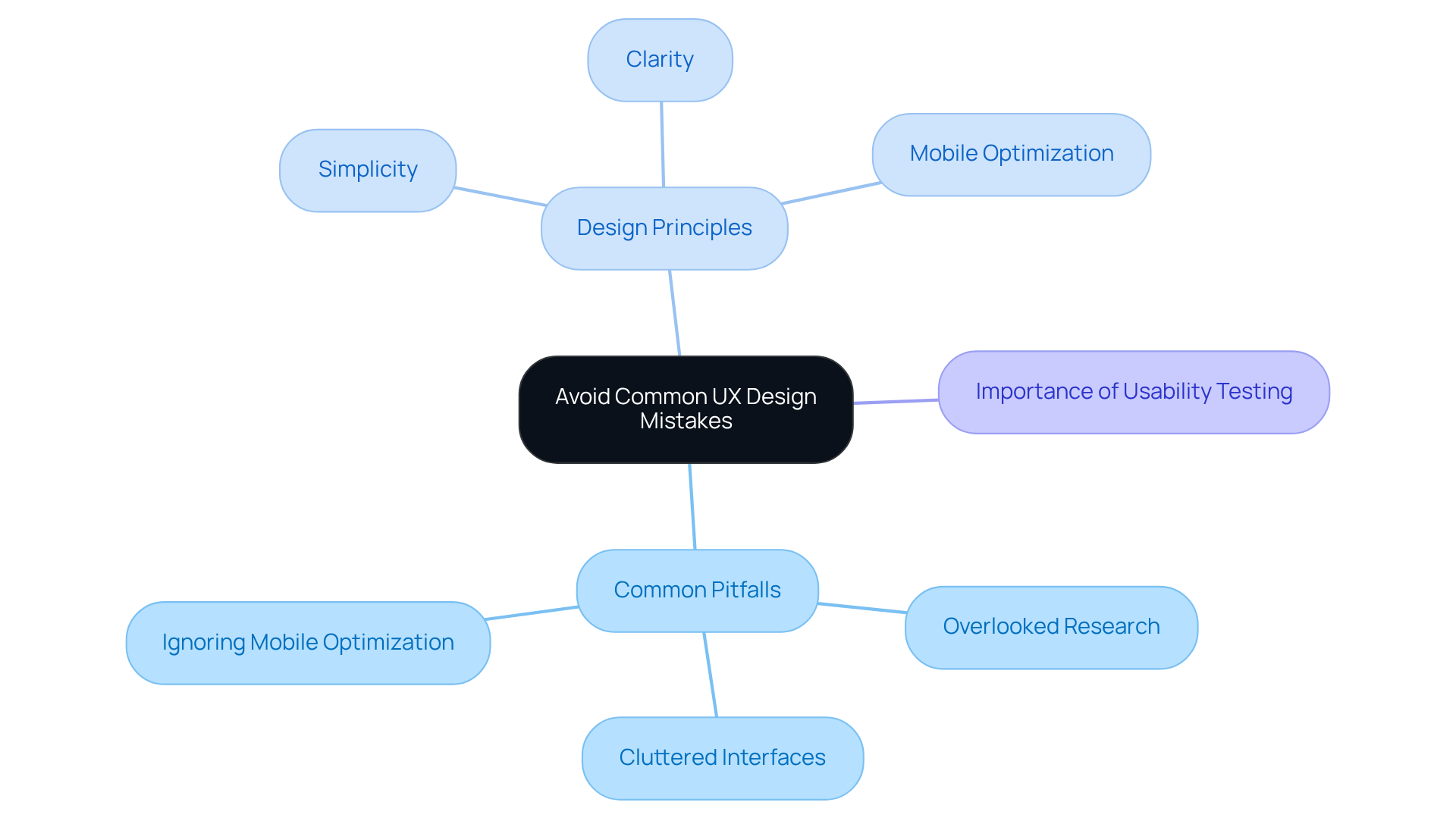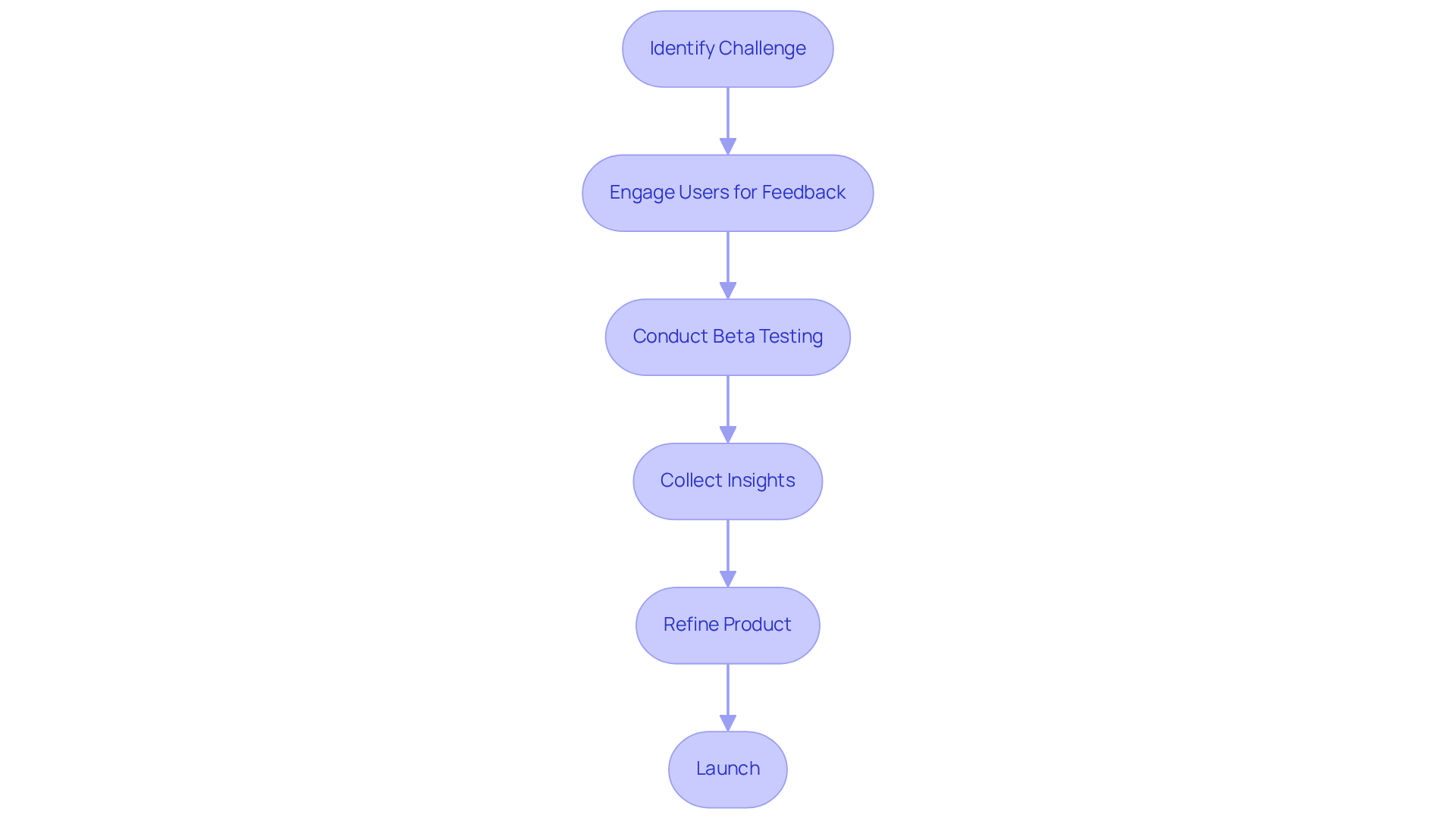Overview
The article highlights a significant challenge that tech startups often face: mastering UX design for the web. This is not just a technical hurdle; it can deeply affect a startup's potential for success. Many founders find themselves overwhelmed, struggling to balance user needs with business goals. This can lead to frustration and missed opportunities.
However, there is hope. By focusing on user research, implementing structured processes, and steering clear of common pitfalls, startups can enhance their product's success. Effective user analysis and iterative design are essential. When we prioritize simplicity, we open the door to improved user engagement and satisfaction. This, in turn, can lead to higher conversion rates and greater market success.
Imagine the relief of seeing your product resonate with users, knowing that your efforts in understanding their needs have paid off. With the right approach, you can transform your challenges into triumphs. Embracing these strategies not only fosters a better user experience but also builds a supportive community around your product. We believe that every startup can thrive with the right guidance and support, and we are here to help you navigate this journey together.
Introduction
Crafting an exceptional user experience is not just important; it is a cornerstone of success for tech startups. Yet, many founders often feel overwhelmed by the complexities of truly understanding their users. This struggle can lead to frustration and missed opportunities. By prioritizing user research and implementing a structured UX design process, startups can unlock the potential for increased engagement and satisfaction.
However, the challenge remains: how can startups navigate the common pitfalls in UX design while continuously refining their products to meet the ever-evolving needs of their users? This article explores key practices that can elevate UX design, ensuring that startups not only survive but truly thrive in a competitive landscape.
We’re here to support you on this journey, sharing insights that resonate with your experiences and aspirations.
Prioritize User Research and Understanding
In the journey of tech startups, effectively prioritizing client analysis can often feel overwhelming. Many founders grapple with understanding their customers' true needs and motivations, which can lead to misaligned product features and missed opportunities. This challenge is not just a hurdle; it can significantly impact the success of your venture. However, there is hope. By employing a range of techniques such as surveys, interviews, and usability testing in UX design for web, you can gain valuable insights into your clients' experiences.
Start by establishing clear objectives that align with your product goals. Utilizing tools like Google Analytics can provide you with quantitative data on visitor behavior, but it’s essential to enrich this data with qualitative insights gathered from participant interviews. Developing client personas based on this research is crucial for UX design for web, as it helps ensure that your design remains focused on genuine needs. For instance, consider a startup that created a fitness application. They took the time to interview individuals, seeking to understand the motivations and challenges faced by their target audience. This thoughtful approach led to the implementation of features that significantly boosted engagement and retention rates.
Investing in UX design for web is not just a nice-to-have; it’s a strategic move that can lower your customer acquisition costs and enhance your market share. Research shows that for every dollar invested in UX, there’s an average return of $100, translating to a remarkable 9,900% ROI. Furthermore, Jared Spool’s work with a major retailer resulted in a 45% increase in customer purchases, generating an additional $15 million in revenue within just the first month. This illustrates the tangible benefits of comprehensive consumer analysis.
As Ralf Speth wisely stated, 'if quality creation is viewed as costly, one should reflect on the price of poor creation.' This quote beautifully encapsulates the in consumer analysis. By prioritizing your clients' needs and experiences, you not only foster a deeper connection with them but also pave the way for sustainable growth and success in your startup journey.

Implement a Structured UX Design Process
Establishing the project scope and objectives can often feel overwhelming for tech startup founders. This initial phase in a systematic UX design for web process is crucial, yet it is often succeeded by the daunting task of conducting comprehensive research on individuals to inform design choices. Developing wireframes and prototypes becomes essential, as it visualizes the journey of the audience, with tools like Figma and Sketch making this process more manageable.
Integrating feedback loops at every stage allows for iterative enhancements based on testing outcomes, which can significantly alleviate the stress of meeting user expectations. For instance, a technology company that embraced a structured UX development process not only met user expectations but surpassed them, leading to a successful market entry.
Statistics reveal that new ventures employing wireframes and prototypes encounter considerably greater success rates; effective UX has the potential to boost customer conversion rates by as much as 400%. Successful founders often emphasize that investing in these early design stages is vital. As one founder wisely noted, 'Wireframing is not just a step; it's the foundation of our product's success.'
There are numerous instances where businesses have thrived by revamping their application interfaces based on user feedback, resulting in a remarkable 20% rise in feature uptake. By prioritizing wireframes and prototypes, tech startups not only enhance their user experience but also lay the groundwork for effective UX design for web and sustainable growth.
We understand the challenges you face, and by focusing on these , you can foster a nurturing environment for your product's success.

Avoid Common UX Design Mistakes
Frequent UX pitfalls in ux design for web can arise when research is overlooked, interfaces become cluttered with unnecessary features, and mobile optimization is ignored. For startups, it’s essential to focus on simplicity and clarity in their layouts as part of effective ux design for web to enhance the experience for users. Consider a startup that initially launched with a feature-heavy interface; they faced significant usability complaints. However, after refining their layout and concentrating on essential features within their ux design for web, they saw a substantial increase in satisfaction and engagement among their users. This is a reminder that 88% of visitors are less inclined to revisit a site after a , underscoring the need for an intuitive layout.
Regular usability testing plays a crucial role in ux design for web, helping to identify potential issues early in the design process and allowing for timely adjustments that can lead to improved outcomes. As one UX designer wisely stated, 'Simplicity is the ultimate sophistication,' emphasizing that ux design for web can significantly enhance overall satisfaction through a clean, intuitive interface. Moreover, with mobile devices accounting for more than half of global web traffic, ux design for web must prioritize mobile optimization; 80% of individuals find it easier to shop from a mobile-optimized site.
By concentrating on these principles, new ventures can leverage ux design for web to create engaging digital experiences that not only cultivate loyalty but also promote growth. Let’s embrace simplicity together, ensuring that every user feels valued and understood.

Embrace Iteration and Continuous Improvement
In the journey of a startup, executing an iterative design process can feel daunting, especially when it comes to creating consistent feedback loops with clients. This challenge is not uncommon, as many founders grapple with how to effectively gather insights that truly reflect user needs. Engaging in beta testing stages can be a lifeline. Here, real individuals interact with your product, providing invaluable feedback that can shape its future.
Take Dropbox, for example. Their beta launch did more than just test their product; it fostered a community. Participants were rewarded with extra storage for every bug they reported and every friend they referred. This not only enhanced the product but also nurtured customer loyalty, illustrating the power of engagement.
To ensure thorough evaluation, it’s essential that each feature is , aligning with beta testing objectives. Consider a technology company that launched a beta version of their application and actively sought client feedback. This input led to significant design modifications, resulting in a more intuitive and accessible product. By continuously refining based on user feedback, new ventures can keep their offerings relevant and effectively address client needs.
Engaging users during beta testing not only enhances product quality but also helps build a loyal customer base even before the official launch. This positions the startup for greater success in an increasingly competitive market. However, it’s crucial to consider the diversity of beta testers and manage feedback thoughtfully to avoid common pitfalls. Remember, you’re not alone in this process; many have walked this path and emerged stronger, ready to make a meaningful impact.

Conclusion
Mastering UX design is crucial for tech startups striving to create meaningful digital experiences. Many founders face the daunting challenge of aligning their products with user needs, which can feel overwhelming. However, by prioritizing user research, establishing a structured design process, and avoiding common pitfalls, startups can significantly enhance their offerings and build lasting relationships with customers. Embracing continuous improvement not only helps in meeting user expectations but also positions startups for sustainable growth in a competitive landscape.
Understanding user motivations through research methods like surveys and interviews is vital. These insights lead to the creation of effective client personas, which can be a game-changer for startups. Implementing a structured UX design process, complete with wireframes and prototypes, allows for iterative enhancements based on user feedback. This ensures that the final product resonates deeply with its audience. Moreover, focusing on mobile optimization and avoiding cluttered interfaces are essential steps to enhance user satisfaction and engagement.
In a world where user experience can truly make or break a startup, it is essential to prioritize these UX design practices. By investing in user research and maintaining an agile approach to design, tech startups can improve their customer acquisition strategies and foster a loyal user base that drives long-term success. Embracing these principles will ultimately lead to more intuitive products that meet real user needs, paving the way for innovation and growth in the tech industry. Remember, every small step taken towards understanding and enhancing user experience contributes to a brighter future for your startup.
Frequently Asked Questions
Why is user research important for tech startups?
User research is crucial for tech startups as it helps founders understand their customers' true needs and motivations, preventing misaligned product features and missed opportunities, which can significantly impact the success of the venture.
What techniques can be employed to gain insights into client experiences?
Techniques such as surveys, interviews, and usability testing can be employed to gain valuable insights into client experiences.
How can quantitative data be enriched with qualitative insights?
Quantitative data from tools like Google Analytics can be enriched with qualitative insights gathered from participant interviews, providing a more comprehensive understanding of client behavior.
What is the purpose of developing client personas?
Developing client personas based on research is crucial for UX design, as it helps ensure that the design remains focused on the genuine needs of the users.
Can you provide an example of effective user research?
An example is a startup that created a fitness application and conducted interviews to understand the motivations and challenges of their target audience, leading to features that significantly boosted engagement and retention rates.
What are the financial benefits of investing in UX design?
Investing in UX design can lower customer acquisition costs and enhance market share. Research shows that for every dollar invested in UX, there’s an average return of $100, equating to a 9,900% ROI.
What is an example of the impact of consumer analysis on revenue?
Jared Spool's work with a major retailer resulted in a 45% increase in customer purchases, generating an additional $15 million in revenue within just the first month, demonstrating the tangible benefits of comprehensive consumer analysis.
What does the quote by Ralf Speth imply about quality creation?
Ralf Speth's quote suggests that if quality creation is seen as costly, one should consider the price of poor creation, highlighting the importance of investing in consumer analysis for sustainable growth and success.




